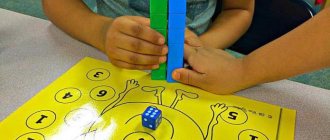Planning for FEMP in preschool educational institutions
It's hard to imagine school without mathematics. Children are prepared for it from a young age. Parents and educators put a lot of effort into ensuring that children have an understanding of basic mathematics. The plan plays an important role. Without it there can be no consistent study of this science. First, the plan is distributed over the year by month. It describes what children should be taught during the year, and what they should know at the end. Then he schedules the month by day (calendar plan). It indicates the days of classes. In the second junior group they are held once a week. The plan describes the goal, tasks, conducting educational games, and getting to know the outside world. Next, a long-term weekly lesson plan is created. Classes in kindergartens follow the same pattern, but the games are presented differently.
For example:
September – 1 week:
1. Task: didactic game “Studying the nesting doll.”
2. Goal: to understand what “one”, “there is not one”, “many” are (to develop ideas about a group of objects).
September – 2nd week:
1. Task: didactic game “Balloons”.
2. Goal: To develop an understanding of shape, variety and colors.
September – 3rd week:
1. Task: Didactic game “Arranging objects correctly.”
2. Goal: learn to develop attention and thinking.
September – 4th week:
1. Task – didactic game “Hide the Bear.”
2. Goal: to learn shapes and objects, how to correctly relate them.
As you noticed, FEMP in the second junior group is studied exclusively through didactic games. You also need to write a plan for other months. Then children, parents and teachers will have no questions left.
Features of quantitative representations
It has been proven that children learn more easily while playing. If you only conduct classes with them, it will be boring, uninteresting, and the kids will quickly stop liking learning new things. Children should be given instructions to form elementary mathematical concepts only in the form of games. In the second younger group, they learn to distinguish when there are many objects and when there are none. Try giving him two toy bunnies and then ask him how many he has. The kid will say: “Here is one and here is one.” If you give a 3.4 year old child 5-6 toys, he will say: “That’s a lot.”
You can hide them for 3 minutes and ask: “How many toys do you have?” The child will answer: “There is not one.” These are general answers. They may differ depending on the individuality of the baby, but the meaning will be the same. This applies to those children who cannot count.
What should children be able to do at the end of the school year?
When all the lessons that were planned have been completed, then you can consolidate what you have learned with the kids. As a result, children should be able to:
1. Find out how many items they have (many, few, none).
2. Must understand the difference between big and small.
3. What kind of strip, ribbon, path (wide-narrow, long-short).
4. Where the toy is thick, where it is thin.
5. What is morning or night.
6. Must be able to determine: what is below, above, in front, behind, on the left, on the right.
7. Where is their head, arms, legs, etc.
8. Must distinguish between shapes and colors.



